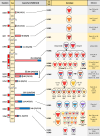Epidemiology and pathobiology of H5Nx highly pathogenic avian influenza in South Korea (2003-2024): a comprehensive review
- PMID: 40332021
- PMCID: PMC12064103
- DOI: 10.1080/01652176.2025.2498918
Epidemiology and pathobiology of H5Nx highly pathogenic avian influenza in South Korea (2003-2024): a comprehensive review
Abstract
Since their emergence in Guangdong, China, in 1996, Gs/GD H5 highly pathogenic avian influenza viruses (HPAIVs) have diversified into multiple clades, spreading globally through wild bird migrations and causing substantial losses in poultry and wildlife. In South Korea, HPAIVs, including H5N1, H5N8, and H5N6 subtypes, have been repeatedly introduced since 2003. This review examines the epidemiology, genetic characteristics, and pathobiological features of these viruses in South Korea. Outbreaks typically occur between October and December, aligning with the arrival of wintering migratory birds. While outbreaks in poultry farms dominated before 2018, wild bird cases became more prevalent in subsequent years. Seasonal outbreaks in poultry have declined, but large-scale mortality events in wild birds emerged biennially from 2020. Genotypic diversity has increased since 2014 due to reassortment with low pathogenic viruses, with novel genomic traits detected in recent seasons. Infection studies show consistently fatal outcomes in chickens, while high mortality in domestic ducks was observed only with two of the studied strains, despite efficient transmission. Wild bird studies reveal species-specific roles in viral shedding and transmission. This review underscores the dynamic nature of HPAI outbreaks, highlighting the importance of surveillance, biosecurity, and genetic and pathogenicity analyses to mitigate future risks.
Keywords: Highly pathogenicity avian influenza; characteristics; outbreak; poultry; republic of Korea; wild bird.
Conflict of interest statement
No potential conflict of interest was reported by the author(s).
Figures

References
-
- APQA . 2018. Epidemiological investigation report on highly pathogenic avian influenza (2014-2016). APQA e-book Library. https://ebook.qia.go.kr/20180306_101633.
-
- Bae Y-J, Lee S-B, Min K-C, Mo J-S, Jeon E-O, Koo B-S, Kwon H-I, Choi YK, Kim J-J, Kim J-N, et al. . 2015. Pathological evaluation of natural cases of a highly pathogenic avian influenza virus, subtype H5N8, in broiler breeders and commercial layers in South Korea. Avian Dis. 59(1):175–182. doi: 10.1637/10921-081914-case. - DOI - PubMed
-
- Baek Y-G, Lee Y-N, Lee D-H, Shin J-I, Lee J-H, Chung DH, Lee E-K, Heo G-B, Sagong M, Kye S-J, et al. . 2021. Multiple reassortants of H5N8 clade 2.3. 4.4 b highly pathogenic avian influenza viruses detected in South Korea during the winter of 2020–2021. Viruses. 13(3):490. doi: 10.3390/v13030490. - DOI - PMC - PubMed
Publication types
MeSH terms
LinkOut - more resources
Full Text Sources
Other Literature Sources
Medical
